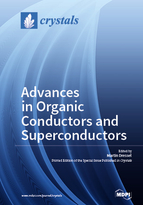Advances in Organic Conductors and Superconductors
A special issue of Crystals (ISSN 2073-4352).
Deadline for manuscript submissions: closed (31 March 2018) | Viewed by 93372
Special Issue Editor
Interests: condensed matter physics; solid state spectroscopy; correlated electron systems; low-dimensional materials; molecular conductors; superconductors; optical and magnetic properties; electrodynamics
Special Issue Information
Dear Colleagues,
Crystalline conductors and superconductors based on organic molecules are a rapidly progressing field of solid-state science, comprising chemists, and experimental and theoretical physicists from all around the world. In focus are solids with electronic properties governed by delocalized π-electrons. Although carbon-based materials of various shades have gained enormous interest in recent years; however, charge transfer salts are still paradigmatic in this field. Progress in molecular design is achieved via tiny but ingenious modifications, as well as by fundamentally different approaches. The wealth of exciting physical phenomena is unprecedented and could not be imagined when the field took off almost half a century ago. Organic low-dimensional conductors are prime examples of Luttinger liquids, exhibit a tendency toward Fermi surface instabilities, but can also be tuned across a dimensionality driven phase diagram like no other system. Superconductivity comes at the border to ordered phases in the spin and charge sectors, and, at high fields, the Fulde-Ferrell-Larkin-Ovchinnikov (FFLO) state is well established. The interplay between charge and magnetic order is still under debate, but electronic ferroelectricity is well established. After decades of intense search, the spin liquid state was first discovered in organic conductors when the amount of geometrical frustration and electronic correlations are just right. They drive the metal and superconductor into an insulating Mott state, solely via electron–electron interactions. However, what do we know about the effect of disorder? Can we tune the electronic properties by pressure, by light, or by field? Research is still aiming at basic questions, but devices are not out of reach. These are currently open questions, as well as hot and timely topics. In 2012, Reizo Kato edited a seminal collection of 45 contributions on various aspects of “Molecular Conductors” as a Special Issue of Crystals, which, at present, has received more than 260 citations. The present Special Issue on “Advances in Organic Conductors and Superconductors” may become a status reports summarizing the progress achieved in the last five years.
Prof. Dr. Martin Dressel
Guest Editors
Manuscript Submission Information
Manuscripts should be submitted online at www.mdpi.com by registering and logging in to this website. Once you are registered, click here to go to the submission form. Manuscripts can be submitted until the deadline. All submissions that pass pre-check are peer-reviewed. Accepted papers will be published continuously in the journal (as soon as accepted) and will be listed together on the special issue website. Research articles, review articles as well as short communications are invited. For planned papers, a title and short abstract (about 100 words) can be sent to the Editorial Office for announcement on this website.
Submitted manuscripts should not have been published previously, nor be under consideration for publication elsewhere (except conference proceedings papers). All manuscripts are thoroughly refereed through a single-blind peer-review process. A guide for authors and other relevant information for submission of manuscripts is available on the Instructions for Authors page. Crystals is an international peer-reviewed open access monthly journal published by MDPI.
Please visit the Instructions for Authors page before submitting a manuscript. The Article Processing Charge (APC) for publication in this open access journal is 2600 CHF (Swiss Francs). Submitted papers should be well formatted and use good English. Authors may use MDPI's English editing service prior to publication or during author revisions.
Keywords
- synthesis of novel molecules and crystal growth of new organic conductors
- molecular superconductors
- molecular Dirac electron systems and zero-gap conductors
- Molecular π-d systems
- organic FET, molecular electronics and spintronics
- strongly correlated electron systems
- metal-insulator transition, Mott transition
- charge order, electronic ferroelectricity of molecular materials
- molecular spin liquids, geometrical frustration
- photo-induced phenomena, non-equilibrium physics
- disorder effects in organic conductors
- pressure effects
- X-ray diffraction
- vibrational spectroscopy
- optical properties
- non-linear phenomena
- transport properties
- dielectric properties
- magnetic properties
- NMR and ESR
- thermodynamic properties
- electronic state calculations
- theoretical models






